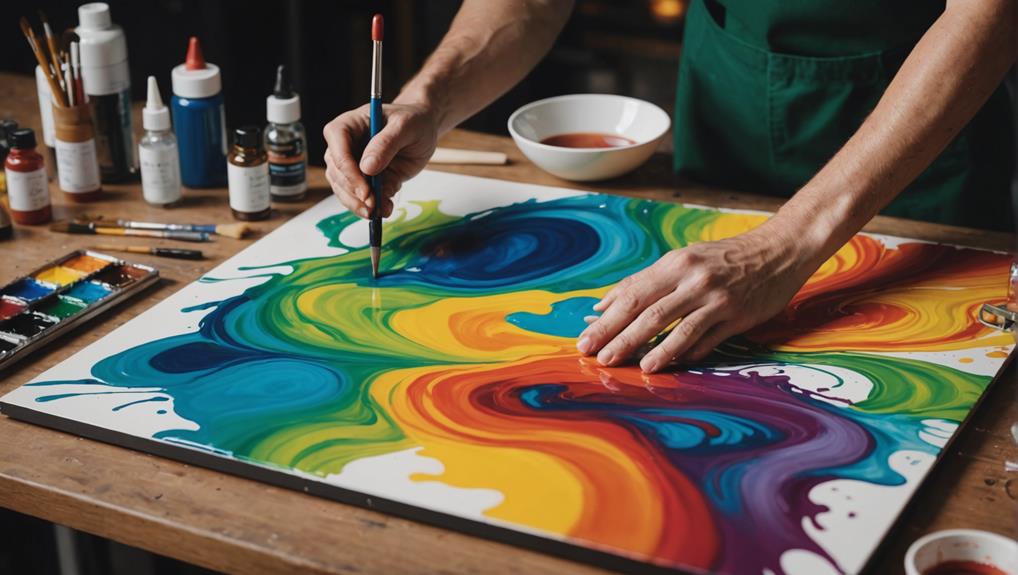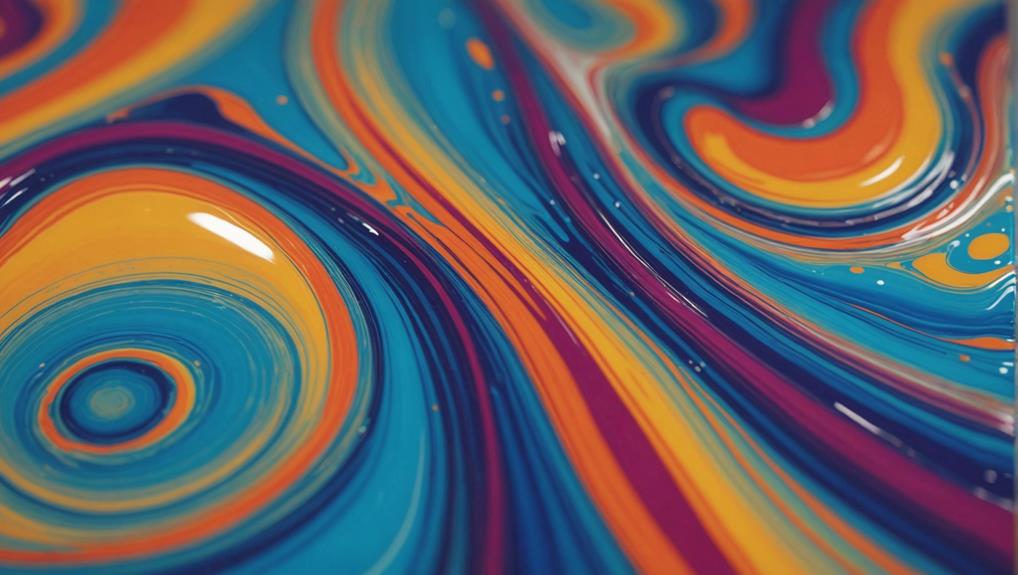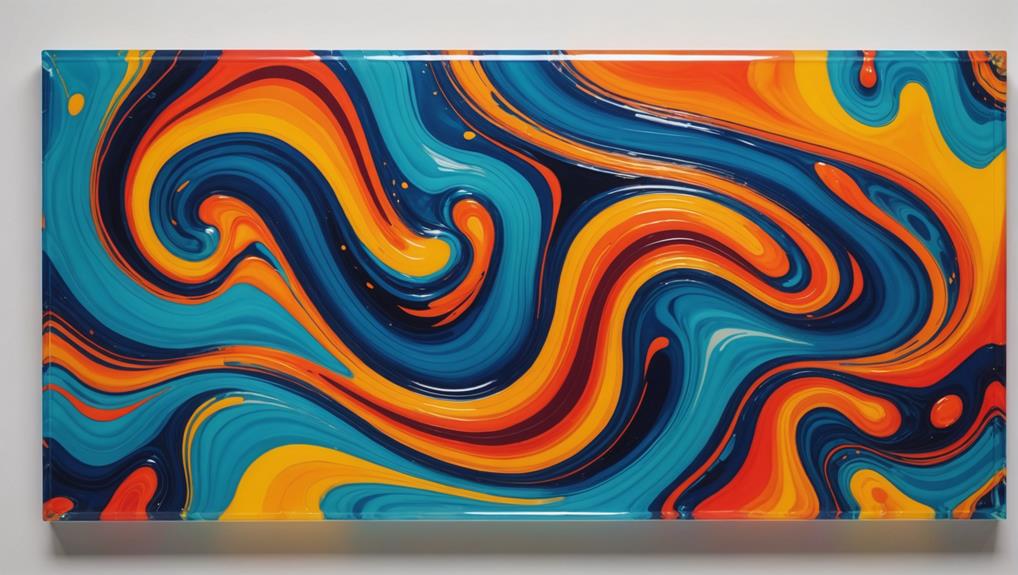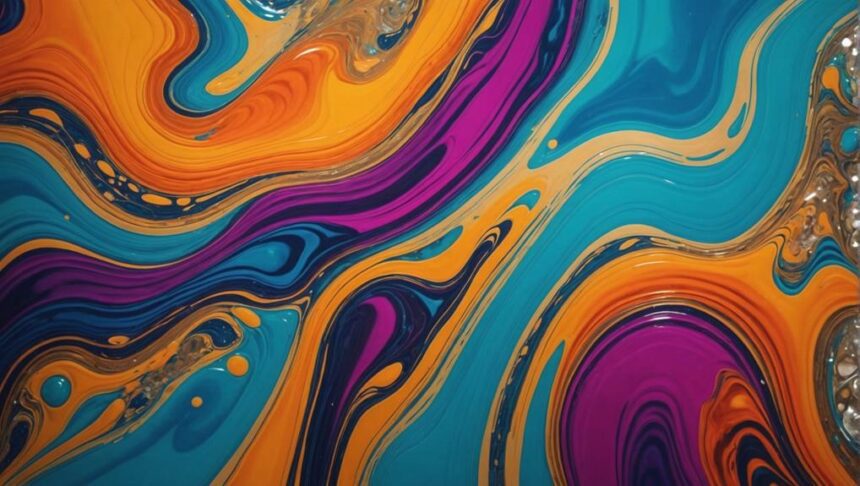Achieving a glossy finish in fluid art is a harmony of timing, patience, and technique. First, let your painting cure properly—three weeks for Dutch pours and four weeks for flip cups—so the varnish doesn’t trap moisture. Clean your canvas gently with a microfiber cloth to remove any dust. Choose a high-quality varnish like Liquitex Professional High Gloss Varnish, and remember to stir it instead of shaking to avoid bubbles. Apply four thin, even coats, rotating the canvas between layers to cover every inch. Pay attention to puddles and bubbles under bright light for a flawless, sleek finish. Ready to make your masterpiece shine even more?
Key Takeaways
- Allow paintings to fully cure for 3-4 weeks before applying varnish to ensure a flawless finish.
- Clean the canvas with a soft, lint-free cloth to remove dust before varnishing.
- Choose Liquitex Professional High Gloss Varnish and apply in thin, even layers.
- Rotate the canvas 90 degrees between coats for consistent varnish coverage.
Curing Time
Proper curing time is essential for achieving a flawless, glossy finish in fluid art. Curing techniques play a crucial role in ensuring that your masterpiece not only shines but also stands the test of time.
For instance, Dutch pour paintings need a curing period of about three weeks before you can even think about varnishing them. This is because the paint layers are generally thinner, allowing them to dry a bit faster. On the other hand, flip cup and straight pour techniques, which involve thicker layers of paint, require a longer curing time of four weeks.
Why is curing so important? Well, if the paint hasn’t fully cured, moisture could get trapped beneath the varnish, leading to unsightly imperfections. This process allows the paint to dry completely and stabilize, ensuring that the varnish adheres properly when you apply it.
Trust me, waiting for the proper curing time can make a world of difference in the longevity and vibrancy of your art. So, always make sure your painting has thoroughly cured before varnishing to achieve that perfect, glossy finish. Your patience will pay off in a beautiful, enduring piece of art.
Cleaning Canvas
After your painting has fully cured, the next vital step towards achieving a glossy finish is cleaning the canvas meticulously.
Canvas maintenance is essential to guarantee that your final product shines brilliantly. Start by using a soft, lint-free cloth to gently wipe the surface. The key here is to be gentle; you don’t want to damage the paint layer you’ve worked so hard on.
One of the most important cleaning techniques is to avoid adding any moisture during this process. Moisture can be your worst enemy at this stage, potentially trapping water under the varnish and ruining the glossy finish you’re aiming for. Just stick to a dry dust wipe to remove any dust or debris that may have settled on the surface.
Timing is also vital. Make sure your painting has cured for the appropriate time—three weeks for Dutch pour paintings and four weeks for flip cup or straight pour paintings. Rushing this step can lead to disappointing results.
Proper cleaning of the canvas is vital for achieving that polished, professional look once you apply the varnish. So take your time, be thorough, and your efforts will surely pay off with a stunning, glossy finish.
Choosing Varnish
Selecting the right varnish is essential for achieving a high-quality glossy finish in fluid art. Among various varnish types, Liquitex Professional High Gloss Varnish stands out for its ability to enhance the vibrancy of your artwork. This varnish is specifically formulated to give your fluid art that superior glossy finish you’re aiming for.
When it comes to application techniques, it’s important to avoid shaking the varnish container. Shaking can create bubbles, which might mess up the smoothness of your finish. Instead, gently stir the varnish to mix it. Before you start, make certain your canvas is clean and free of dust. This step is critical to guarantee a flawless appearance once the varnish is applied.
For the best results, apply the varnish in thin layers. Multiple thin coats are much better than one thick layer because they give a more even and glossy finish. After each coat, inspect your artwork in good light to check for even coverage and to spot any bubbles or imperfections that need fixing. This careful attention will help you achieve that stunning, glossy look you’re after in your fluid art.
Preparation Tools
To achieve that perfect glossy finish, it’s essential to have the right preparation tools at your fingertips.
Start with a clean canvas by wiping away any dust to prevent pesky debris from ruining your varnish.
Equip yourself with essentials like Liquitex Professional High Gloss Varnish, varnishing sponges wrapped in nylon pop socks, and gloves to keep everything neat and smooth during application.
Essential Varnishing Supplies
Consistently achieving a polished, glossy finish in fluid art requires the right varnishing supplies and meticulous preparation. Selecting the appropriate varnish type is vital; Liquitex Professional High Gloss Varnish is highly recommended for its ability to enhance color vibrancy and protect the artwork. While varnish types vary, alternatives such as resin can also be considered, though they often require more advanced techniques and safety precautions.
Preparation tools play a significant role in ensuring a flawless varnishing process. A varnishing sponge wrapped in nylon pop socks is an ingenious solution to prevent debris from contaminating the varnish during application. This simple yet effective tool helps maintain the integrity of the varnish layer, ensuring a smooth and glossy finish.
Timing is another important factor. Allowing the appropriate curing time—three weeks for Dutch pour paintings and four weeks for flip cup or straight pour paintings—ensures that moisture is not trapped beneath the varnish, which could compromise the finish.
Additionally, wearing gloves during varnish application is essential to avoid transferring residue onto the artwork, maintaining a clean and professional look. By paying attention to these essential varnishing supplies and preparation steps, artists can achieve a stunning, glossy finish in their fluid art creations.
Cleaning Canvas Properly
Properly cleaning the canvas before varnishing is fundamental to achieving a flawless, glossy finish.
Canvas maintenance is an important step that guarantees the removal of any dirt or debris that might mar the final appearance of your artwork.
To begin with, it is important to use a clean, dry cloth or a microfiber dust wipe for dust removal. This method is effective in eliminating particles without introducing moisture, which could negatively impact the varnishing process.
It’s also essential to confirm that the canvas has fully cured: three weeks for Dutch pour paintings and four weeks for flip cup or straight pour paintings. This waiting period helps prevent any trapped moisture under the varnish.
Avoid using any chemicals or wet cleaning solutions, as these might alter the paint and potentially ruin your work.
Here are some important tips for cleaning your canvas:
- Use a microfiber dust wipe to gently remove any dust and debris.
- Confirm the canvas has cured completely before starting the varnishing process.
- Avoid using chemicals or wet solutions that might damage the paint.
Handling Varnish Safely
Guaranteeing safe handling of varnish requires the right preparation tools and techniques to achieve a professional finish. Varnish safety is vital, starting with a clean and dust-free canvas. Before varnishing, use a dust wipe to remove any particles, as moisture can jeopardize the process.
Next, let’s talk about the varnishing sponge. Wrap it in nylon pop socks to prevent debris from contaminating your application. This simple trick can save you from frustrating imperfections later on. When using Liquitex Professional High Gloss Varnish, avoid shaking the bottle to steer clear of bubbles that could ruin your glossy finish.
Wearing gloves is another essential step. They not only protect your hands from the varnish but also guarantee no residue interferes with your artwork. Proper lighting is your best friend during this process. It helps spot any bubbles or imperfections, allowing for timely corrections.
Lastly, varnish storage is important. Keep your varnish in a cool, dry place to maintain its quality. Following these steps will help you handle varnish safely and achieve that desired, professional glossy finish in your fluid art.
Varnishing Process

It’s finally time to give your fluid art that stunning, glossy finish with the varnishing process.
First, make sure your painting has cured completely, which means waiting three weeks for Dutch pours and four weeks for flip cup or straight pour techniques.
Next, clean the canvas gently and get ready to apply those smooth, thin layers of varnish for that perfect shine.
Preparing for Varnishing
Allowing your fluid art to cure fully is important to avoid trapping moisture under the varnish. Different techniques require varying curing times; for instance, Dutch pour paintings need about 3 weeks, whereas flip cup or straight pour paintings take around 4 weeks.
Once cured, it’s time to think about the varnish types. For achieving those stunning gloss finishes, Liquitex Professional High Gloss Varnish is a top choice.
To prepare your canvas for varnishing, follow these steps:
- Clean the canvas: Use a dust wipe to remove any debris. It’s essential to make sure no moisture is added during this process.
- Prepare your varnishing tools: A varnishing sponge wrapped in nylon pop socks helps minimize debris contamination.
- Avoid shaking the varnish: This precaution prevents bubbles from forming in the varnish which can ruin the smooth finish.
These preparation steps are important in achieving a flawless, glossy finish for your fluid art. Taking the time to properly prepare guarantees your art will have that professional, high-gloss look you desire.
Applying Thin Coats
When applying thin coats of varnish to your fluid art, begin by using a varnishing sponge wrapped in nylon pop socks to achieve a debris-free application. This is a vital step in varnish techniques, as it guarantees a smooth, clean surface and keeps your art looking pristine.
First, wait at least 3 to 4 weeks for your painting to fully cure. This prevents any trapped moisture, which can ruin your finish.
Start by applying a thin layer of Liquitex Professional High Gloss Varnish down one side of the canvas, then wipe it across the painting in a consistent direction. Remember, layer thickness is key—thin is better!
Rotate the canvas 90 degrees for each subsequent coat. This cross-directional approach helps in achieving even coverage. Aim for a total of four thin coats.
As you work, check for puddles and use light to inspect the surface. Consistent wiping motions help maintain a uniform finish.
Applying First Coat
Before applying the first coat of varnish to your fluid art piece, make sure the painting has cured for the recommended period to prevent moisture entrapment. Dutch pour paintings need at least three weeks to cure, while flip cup and straight pour paintings require four weeks. This patience guarantees a flawless finish.
Start by cleaning the canvas with a dust wipe to remove any debris. Dust particles can mar your glossy finish, so thorough cleaning is essential.
Next, use a varnishing sponge wrapped in nylon pop socks to apply the varnish. Begin at one side of the canvas, wiping across in a consistent direction. This varnish application technique helps achieve an even and smooth first layer.
Remember to rotate the canvas 90 degrees for each subsequent coat. This cross-directional method guarantees uniform coverage and prevents uneven thickness. As you apply the varnish, always wear gloves to avoid leaving any residue on your artwork. Additionally, check along the edges for bubbles that might appear during the process, as they can disrupt the smooth finish.
- Clean the canvas thoroughly before varnishing.
- Use a varnishing sponge wrapped in nylon pop socks.
- Rotate the canvas 90 degrees for each coat.
Checking for Puddles
After applying the first coat of varnish, it is imperative to check for puddles to guarantee a flawless finish. Envision this: you’ve worked hard on your fluid art piece, and now the varnish decides it wants to throw a mini pool party on your canvas! To avoid this, puddle prevention is key.
Start by observing the varnished surface under bright light. This helps reveal any areas where varnish has pooled. Thick applications are a no-go; they love to create puddles. Instead, go for thin layers.
Now, don’t just rely on your eyes—use your fingers too! Gently run them along the edges of the canvas. If you feel bubbles or uneven spots, you’ve got a puddle situation.
Regular varnish inspection is your best friend here. After each coat, give the surface a good look to make sure the varnish is even and smooth before it dries. Think of yourself as a varnish detective, hunting down those pesky puddles.
With these steps, you’ll be well on your way to achieving that glossy, professional finish that makes your art shine!
Rotating Canvas
Rotating the canvas 90 degrees after each coat of varnish guarantees even application and enhances the final appearance of the artwork. This simple yet effective technique assures that the varnish settles uniformly, creating a professional finish free from unsightly pooling. By turning the canvas, you also enable the creation of cross-directional layers, which is one of the key canvas rotation benefits. These layers contribute to a more dynamic and textured surface, an essential aspect of artistic layering techniques.
To maximize the benefits of rotating your canvas, consider these points:
- Uniform Coverage: Rotating allows you to apply each coat in a consistent direction, helping the varnish spread evenly.
- Enhanced Aesthetic: The cross-directional layers add depth and dimension, enriching the visual appeal of the artwork.
- Longevity: Even application prevents areas from becoming too thick or too thin, contributing to the durability and vibrancy of the piece.
Incorporating canvas rotation into your varnishing process not only improves application but also greatly enhances the overall quality and longevity of your fluid art masterpiece.
Multiple Coats
Applying multiple coats of varnish is fundamental to achieving a glossy, professional finish in fluid art. To truly enhance the visual aesthetics of your masterpiece, you should aim for a total of four thin coats.
Begin by applying the first coat with a consistent wiping motion, working down one side of the canvas and then across the painting. This guarantees a uniform varnish application.
After the first coat, rotate your canvas 90 degrees before applying the next layer. This cross-directional layering ensures even distribution and helps avoid any streaks or uneven areas.
Shining a light on the surface can help you inspect each coat for puddles and bubbles, essential for maintaining a smooth, glossy finish.
Handling Varnish
To handle varnish effectively, confirm that your workspace is dust-free and well-ventilated to maintain the integrity of your fluid art. This step is vital to avoid any debris settling on your artwork during the varnish application.
Before you begin, verify your painting has cured properly—three weeks for Dutch pours and four weeks for flip cup or straight pours. This prevents moisture from becoming trapped under the varnish, which can ruin your glossy finish.
Begin by cleaning your canvas with a dust wipe, making sure no moisture is added. Opt for a high-quality varnish like Liquitex Professional High Gloss Varnish, applied with a varnishing sponge wrapped in nylon pop socks to keep contaminants at bay.
Here are key steps to follow for a flawless finish:
- Thin Layers: Apply thin layers of varnish in one direction.
- Canvas Rotation: Rotate the canvas for subsequent coats.
- Lighting Check: Inspect for even coverage and bubbles under good lighting.
Following these steps will help you achieve a beautiful, professional-looking glossy finish on your fluid art.
Edges and Bubbles

When working on achieving that perfect glossy finish, it’s essential to pay attention to both the edges of your canvas and those pesky bubbles.
As you apply varnish, make certain to coat the edges thoroughly to protect against moisture damage and fading.
Always keep an eye out for bubbles forming, especially along ridges. If you spot any, gently smooth them out with your fingers or a spatula to guarantee an even, sleek look across your artwork.
Checking for Bubbles
Inspecting the canvas edges for bubbles is an essential step in guaranteeing a smooth, glossy finish in fluid art. Bubble prevention is key to maintaining that flawless sheen, and edge inspection plays a significant role in this process. When you apply varnish, it’s important to carefully check the edges for any bubbles that might form along the ridges. These tiny imperfections can ruin an otherwise perfect finish.
To help guarantee a bubble-free surface, consider the following tips:
- Thin Coats: Apply each coat of varnish thinly to prevent pooling, which often leads to bubble formation.
- Light Source: Use a light source to shine on the varnished surface, making it easier to spot bubbles and uneven areas.
- Finger Smoothing: If bubbles are detected, gently run your fingers along the edges to smooth them out and eliminate any imperfections.
Handling Canvas Edges
Properly handling the edges of the canvas during the varnishing process is vital for achieving a seamless, glossy finish. Applying varnish to the edges not only guarantees a cohesive look but also prevents moisture from seeping in and damaging your artwork. One of the effective canvas edge techniques involves using a varnishing sponge wrapped in nylon pop socks. This method helps minimize the introduction of debris, giving you cleaner edges.
To achieve even coverage, start by applying varnish down one side of the canvas, then move across the edges using a consistent wiping motion. This varnish application tip is essential for maintaining a smooth finish. After applying, run your fingers gently along the edges to check for any bubbles. These bubbles can disrupt the smooth appearance and lead to an uneven texture, so it’s important to catch them early.
Inspect the edges under light to verify the varnish is evenly distributed and free from any pooling or bubbles before allowing it to dry. This careful inspection will help you achieve that perfect glossy finish.
| Step | Action | Purpose |
|---|---|---|
| 1 | Apply varnish to one side of the canvas | Guarantee even coverage |
| 2 | Move across edges with a consistent motion | Maintain a smooth finish |
| 3 | Use varnishing sponge wrapped in nylon | Minimize debris introduction |
| 4 | Run fingers gently along edges | Check for bubbles |
| 5 | Inspect edges under light | Confirm even distribution and no pooling |
Smoothing Bubble Ridges
Addressing bubble ridges effectively involves gently running your fingers along the varnished edges to smooth out any imperfections. This hands-on approach is vital for achieving that glossy, flawless finish in your fluid art.
Bubble ridge techniques can be a game-changer, making the difference between a professional-looking piece and one that seems rushed.
To make sure you get it right, here are some varnish application tips to keep in mind:
- Shine a light: Use a light source to check for bubbles along the ridges. This will help you identify any areas that need smoothing out before the varnish dries.
- Thin layers: Always apply thin layers of varnish. Thick layers can pool and create more bubbles, making your job harder.
- Wear gloves: Gloves are essential. They prevent any residue from your hands from getting onto the artwork, which could create additional texture issues.
Inspecting Final Coat
Carefully examine the surface under bright light to identify any imperfections or inconsistencies in the final coat of varnish. This step is vital for guaranteeing a flawless finish. During the final inspection, look closely for surface imperfections such as bubbles, streaks, or uneven areas that might have formed. A thorough examination helps assure the desired glossy outcome.
Run your fingers gently along the edges to detect any bubbles that may have formed during the application process. If you find any, address them promptly to maintain a smooth texture. Make certain that all varnish layers are thin to prevent pooling, which can lead to an uneven finish. Confirm your satisfaction with the overall glossiness and consistency before allowing the artwork to dry completely.
To promote an even sheen, take the time to observe your artwork from multiple angles. This step guarantees that the finish appears consistent and vibrant across the entire surface.
Here’s a quick checklist to guide you during the inspection:
| Step | Action | Goal |
|---|---|---|
| Bright Light Check | Examine the surface under bright light. | Identify imperfections or inconsistencies |
| Edge Inspection | Gently run fingers along the edges. | Detect and address any bubbles |
| Thin Layers | Make certain varnish layers are thin. | Prevent pooling and uneven texture |
| Multi-Angle View | Observe artwork from different angles. | Confirm even sheen and vibrancy |
Vibrancy and Protection

Varnishing fluid art not only enhances color vibrancy but also provides essential protection against environmental factors. Applying a high gloss varnish can make colors pop, giving your artwork a stunning, dynamic look. This is especially important in fluid art, where color theory plays a significant role in the overall aesthetic impact. Varnishing can make metallics shimmer and glitters sparkle, turning your piece into a true visual masterpiece.
Moreover, varnishing serves as a protective shield, guarding your art against dust, UV damage, and other environmental factors that could potentially degrade its quality over time. This guarantees that your artistic expression remains as vibrant and striking as the day it was created. The reflective quality of a glossy finish also adds depth and dimension, enhancing the texture of your artwork without obscuring it.
Here are some key benefits of varnishing in fluid art:
- Enhanced Color Vibrancy: Deepens colors and makes metallics and glitters stand out.
- Protection: Shields the artwork from dust, UV rays, and other damaging elements.
- Light Reflection: Glossy surfaces reflect light, adding a luminous quality to the piece.
Incorporating these elements guarantees your fluid art remains both visually stunning and well-preserved.
Enhancing Colors
Applying a glossy varnish greatly enhances the vibrancy and richness of colors in fluid art, making each hue more striking and saturated. This enhancement taps into basic principles of color theory, where glossy finishes amplify the light reflection, making colors appear more intense and visually appealing.
When a varnish is applied correctly, metallics and shimmers within the artwork become accentuated, adding depth and intrigue. This visual perception creates a dynamic experience where the viewer’s eye is drawn to the richness of colors and the interplay of light on the surface.
The process of applying a glossy varnish involves multiple thin coats, which helps maintain color integrity and prevents dullness over time. This step is essential for guaranteeing that the colors remain as vibrant as when they were first poured.
Different pouring techniques, such as ring pours and Dutch pours, offer varying levels of glossiness, impacting how light is reflected and perceived. A smooth finish from a ring pour will reflect light differently than the more textured finish of a Dutch pour.
Furthermore, allowing a proper curing period before varnishing guarantees that the colors settle fully and no moisture is trapped, safeguarding the artwork’s brilliance.
Viewer Engagement

Engaging with viewers is key to building a vibrant community of fluid art enthusiasts.
Encouraging everyone to subscribe for more tips, share their varnishing experiences, and ask questions guarantees a dynamic exchange of knowledge that benefits all.
Encourage Active Participation
Building an active and engaged community is essential for continuous learning and improvement in the domain of achieving a glossy finish in fluid art. Viewer feedback plays a pivotal role in shaping the content we create, guaranteeing it aligns with the community’s interests and needs. By sharing personal insights and experiences related to varnishing techniques, we create a relatable and open dialogue with our audience.
To further encourage active participation, consider the following strategies:
- Invite Comments and Questions: Actively ask your viewers to share their thoughts and queries, fostering a space where everyone can learn from each other’s experiences.
- Highlight Community Stories: Encourage viewers to share their own varnishing success stories and challenges. This not only builds a richer knowledge base but also strengthens the sense of community.
- Promote Subscriptions: Remind viewers to subscribe to stay updated on new techniques and tips. This guarantees they don’t miss out on valuable information that can help improve their fluid art projects.
Foster Art Technique Sharing
Encouraging viewers to share their unique varnishing techniques and experiences fosters a collaborative environment that enhances collective learning and growth within the fluid art community. By inviting comments and questions on various varnishing methods, we promote interaction and create a supportive space where everyone can benefit from shared knowledge.
When artists discuss their collaborative techniques, they open doors for others to learn new approaches and achieve professional finishes in their artwork. Imagine the joy of discovering a new varnish that gives your piece that perfect glossy shine, all thanks to a fellow artist’s suggestion! Viewer experiences are invaluable as they offer practical insights and real-world results that can be incredibly inspiring.
We should celebrate these shared experiences by giving viewers opportunities to showcase their finished pieces post-varnishing. This not only highlights their progress but also serves as a demonstration of the effectiveness of different techniques. Responding to inquiries about varnishing not only builds a sense of community but also reinforces our shared passion for fluid art.
Build Artistic Community
By actively fostering viewer interaction, you can cultivate a vibrant artistic community where individuals feel valued and connected. One of the most effective ways to build this community is by encouraging viewers to subscribe to your channel for ongoing tutorials and tips related to fluid art techniques and varnishing methods. This consistent flow of information keeps your audience engaged and excited about their artistic journey.
Sharing personal experiences and insights about varnishing and fluid art can create a relatable connection with your viewers. When you open up about your own challenges and successes, you invite others to share their journeys too, promoting a sense of camaraderie and mutual support.
To further enhance this community feeling, actively respond to viewer inquiries. This fosters a dialogue that not only enhances learning but also builds a supportive network among art enthusiasts.
Organizing virtual events or community challenges can also promote interaction and artistic collaboration. These activities provide a platform for viewers to showcase their work, learn from each other, and feel more connected.
- Invite comments and questions from viewers
- Share personal experiences and insights
- Actively respond to viewer inquiries
Frequently Asked Questions
How Do I Make My Art Look Glossy?
To make your art look glossy, guarantee thorough surface preparation and proper color mixing. Apply Liquitex Professional High Gloss Varnish in four thin, cross-directional layers, inspecting for imperfections to achieve an even, vibrant finish.
How to Make Acrylic Pours Shiny?
To make acrylic pours shiny, utilize glossy mediums and precise pouring techniques. Confirm the painting cures for 3-4 weeks, then apply several thin coats of high gloss varnish, addressing bubbles and imperfections between layers for ideal results.
What Do You Put Over Acrylic Paint to Make It Shiny?
To make acrylic paint shiny, apply a high-quality gloss varnish. Among various gloss varnish options, Liquitex Professional High Gloss Varnish is recommended. Additionally, consider using acrylic medium choices like gloss gel medium for enhanced finish.
How Do You Make Thick Glossy Paint?
To create thick glossy paint, adjust the paint viscosity by mixing acrylic paint with glossy mediums like Liquitex Pouring Medium. A 1:1 ratio or higher guarantees a thicker consistency while promoting a glossy finish.
Conclusion
Achieving a glossy finish in fluid art demands meticulous attention to curing time, canvas cleaning, and varnish selection.
Proper use of preparation tools and a careful varnishing process are essential.
Inspecting the final coat confirms vibrancy and protection, which enhances colors and engages viewers.
Following these steps assures a professional, polished result, allowing the artwork’s full potential to shine.
Consistent practice and adherence to these guidelines will yield consistently impressive outcomes.


Leave a Reply